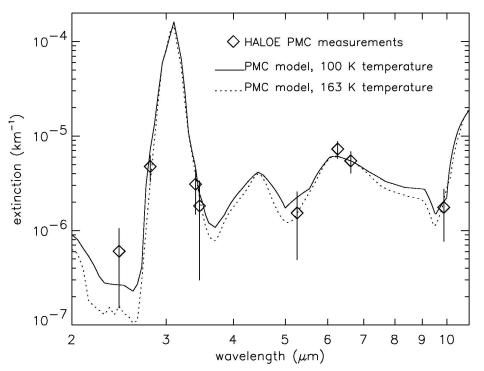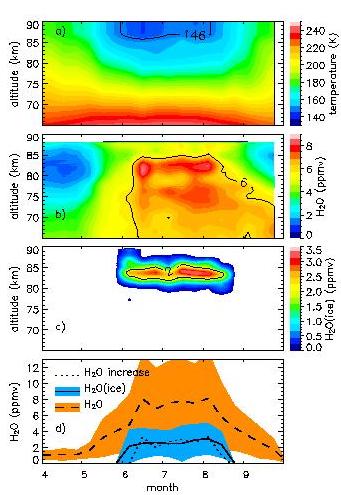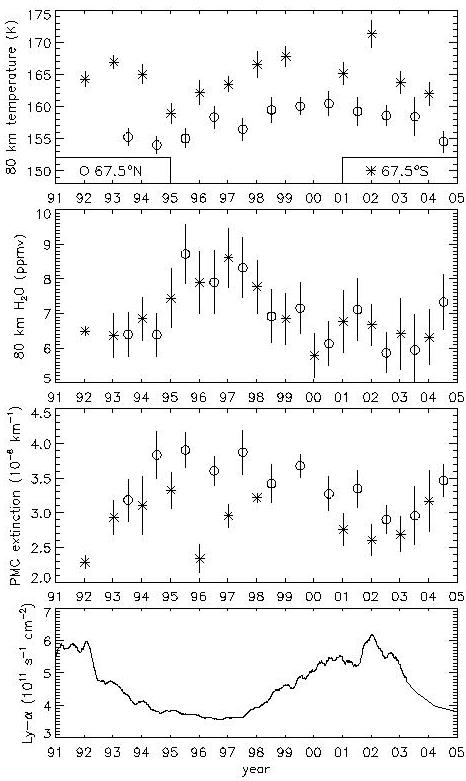Advances in Our Understanding of PMCs and the Mesosphere from HALOE

First confirmation that water ice is the primary component of polar mesospheric clouds
Polar mesospheric clouds (PMCs) were measured in the infrared for the first time by HALOE. The HALOE PMC observations show remarkable agreement with modeled PMC spectra based on ice particle extinction and thus provide the first confirmation that water ice is the primary component of PMCs [Hervig et al., 2001].Left: HALOE PMC extinctions compared to modeled extinction spectra. The HALOE data are averages based on 16 PMC measurements from July 25 to August 4, 1997, between 62°N and 72°N latitude. Vertical bars on each HALOE point represent the standard deviation of these measurements. Model spectra were calculated using the average PMC size distribution from von Cossart et al. [1999] with ice refractive indices from Bertie et al. [1969] for 100 K temperature, and from Toon et al. [1994] for 163 K temperature. The model spectra were scaled to match the HALOE extinction at 6.62 microns wavelength. These scale factors were 0.76 and 0.65 for results based on the Bertie et al. and Toon et al. indices.

Water vapor enhancement in the polar summer mesosphere and its relationship to polar mesospheric clouds
Prior to the PMC season, water
vapor enhancement near 83 km is consistent with a balance between
upwelling and H2O photolysis. During the PMC season, HALOE suggest that
PMC evaporation is the primary driver in continued water vapor
enhancement, resulting in an additional 3 ppmv of H2O near 83 km [Hervig et al., 2003].
Left: Seasonal cross sections of HALOE measurements for 65° - 70°N during 1992-2002 averaged in 10-day time bins. Shown are a) temperature, b) water vapor, and c) the water vapor resulting from PMC evaporation, H2O(ice). d) The average water vapor and H2O(ice) measured at 83.1 km altitude, with standard deviations indicated by shaded regions. The increase in water vapor after PMC appearance ("H2O increase") is also shown. The H2O increase was determined by subtracting the water vapor amount (4.8 ppmv) for the first time bin containing PMCs (June 5) from the entire H2O time series.
Left: Seasonal cross sections of HALOE measurements for 65° - 70°N during 1992-2002 averaged in 10-day time bins. Shown are a) temperature, b) water vapor, and c) the water vapor resulting from PMC evaporation, H2O(ice). d) The average water vapor and H2O(ice) measured at 83.1 km altitude, with standard deviations indicated by shaded regions. The increase in water vapor after PMC appearance ("H2O increase") is also shown. The H2O increase was determined by subtracting the water vapor amount (4.8 ppmv) for the first time bin containing PMCs (June 5) from the entire H2O time series.

Decadal and inter-hemispheric variability in polar mesospheric clouds, water vapor, and temperature
HALOE measurements during 1991
- 2004 indicate decadal cycles in polar mesospheric clouds,
temperature, and water vapor, with expected relationships to the solar
cycle. During solar minimum, northern and southern PMCs were
found to be ~23% brighter than during solar maximum. This change
is apparently related to solar cycle changes in temperature and water
vapor, where the polar mesosphere was both colder and more humid during
solar minimum. The variation in PMC extinction was observed to
lag solar Lyman alpha in both hemispheres. This lag is more
likely related to water vapor than temperature, since water vapor
changes lagged solar activity while temperature changes did not [Hervig and Siskind, 2005].
Left:
Time series of a) 80 km temperature, b) 80 km H2O, and c) peak 3.40 mm
PMC extinction. The data points are for 20 days from solstice
taken from seasonal fits to HALOE measurements at 65-70°N and
65-70°S for each year. d) Solar Ly-a flux data from the SOLAR2000
model.
